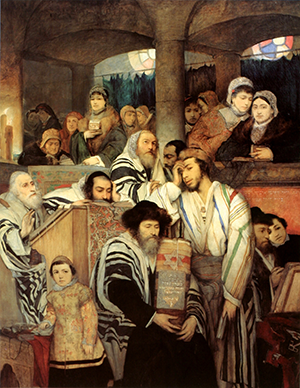Holidays
Yom Kippur
Yom Kippur and Purim, a Tale of Two Holidays

There is an intriguing paradox on the Jewish calendar. The two holidays that seem as distinct from one another as any could be have names that sound oddly similar: Yom Kippur and Purim. To be sure, the root of the term “pur,” which appears in both names, has a different meaning in each. The “pur” in Yom Kippur comes from the word kapparah, meaning “atonement,” a major theme of the holiday. The “pur” in Purim means “lot” and refers to the lots the wicked Haman cast to determine when to destroy the Jews in the kingdom of Persia. Yet early Jewish mystics made a connection between the two names. Yom HaKippurim, the day of Kippurim, they said—using the festival’s biblical name—can be read as a day “k’ Purim,” like Purim.
But how? Purim is a day of masquerades and parties, of boisterously commemorating Haman’s downfall and celebrating the beautiful Queen Esther, who risked her life to save her people. Yom Kippur is a day of fasting and prayer, of searching our souls and confessing our sins as we appeal for forgiveness and salvation. How can they be compared? The answer, the mystics implied, lies in what both holidays tell us about the human condition. Purim points up the vulnerability of the Persian Jews, who had lived in comfortable security until suddenly condemned to death at the whim of an evil man. Yom Kippur reminds us of our own vulnerabilities as we look into ourselves and face our weaknesses and fears, our aspirations and shortcomings. Life is fragile and unpredictable, both holidays tell us. Our time on earth, we chant on Yom Kippur, is like a “fading flower,” a “vanishing dream.” We fast and pray and plead for more time, just as the Jews of Persia fasted and prayed for Esther’s well-being as she prepared to plead with the king for their lives.
Yom Kippur is about our relationship to God, although God remains a mystery to us. While we may not understand a deadly earthquake or a loved one’s suffering, we assume there is a moral order in the universe and that our repentance and supplications have purpose and meaning. God is never mentioned in the Scroll of Esther. Yet, the rabbis said, God is very much involved, a mysteriously hidden presence guiding the action from behind the scenes. That action ends in redemption for the Persian Jews. They are saved and go on to win a resounding victory over their enemies. “For the Jews there was light and gladness, happiness and honor,” the Esther Scroll proclaims, words that have come to symbolize the faith and hope of the Jewish people.
Yom Kippur also ends with a vision of redemption. On this day, tradition holds, Moses descended from Mount Sinai bearing the second Tablets of the Law. He had angrily smashed the first when he discovered the Israelites worshiping a golden calf. His appearance now signified God’s forgiveness for that sin and by extension for all the community’s sins. Belief in that forgiveness echoes throughout Yom Kippur services, and the day concludes for all of us with a sense of having been pardoned, granted a clean slate and new beginning.
The Talmud relates that on Yom Kippur afternoon in ancient times, young women dressed in white danced in the vineyards, to be met there by young men seeking marriage partners. As evening approached, couples paired up, going off together eventually to marry, bear children and continue the Jewish nation. Because of that continuity and because of the promise of salvation, the rabbis regarded Yom Kippur as a “white fast,” a time of optimism and hope, a festival that surpasses even Purim in its anticipation of “light and gladness.”
Francine Klagsbrun’s latest book, a biography of Golda Meir, will be published in 2017 by Schocken Books.










 Facebook
Facebook Instagram
Instagram Twitter
Twitter
Rayzl says
Where in the Talmud does it state that young girls find marriage partners on the afternoon of Yom kipper? Your description sounds a lot like the observance of Tu B’Av.
Please provide your citation. Todah Rabah